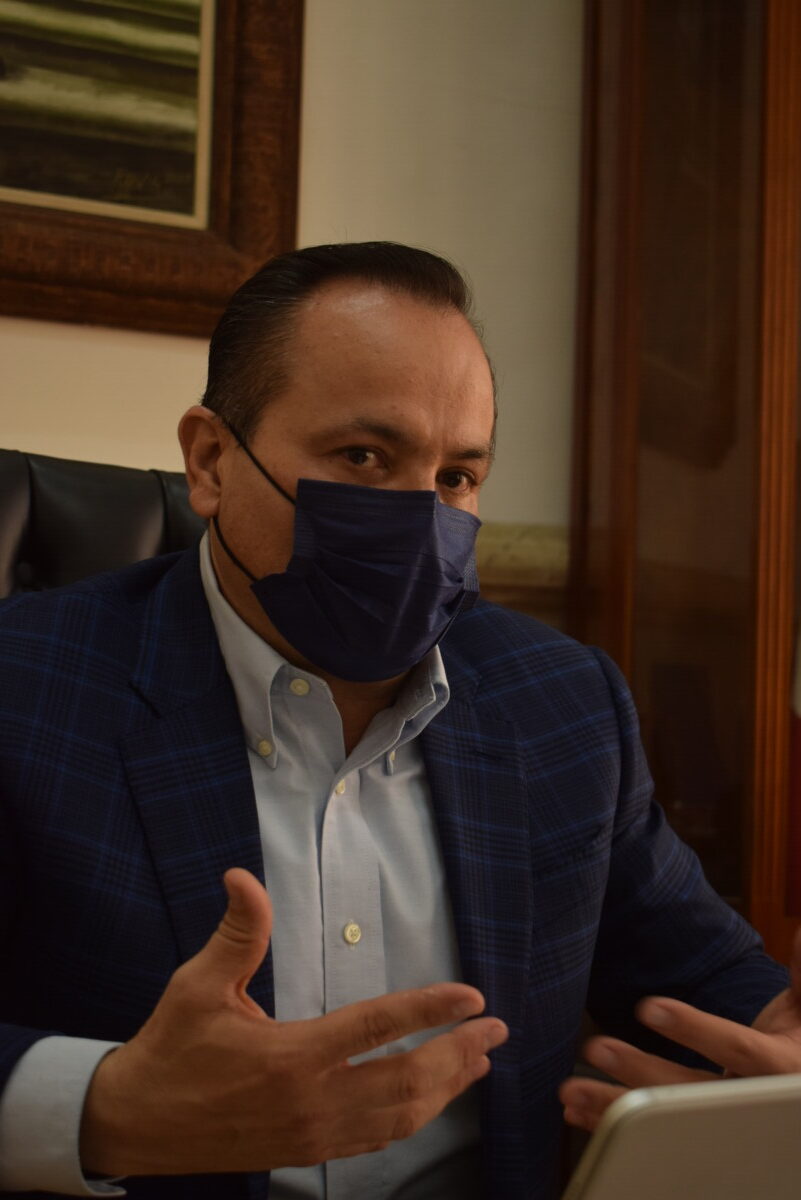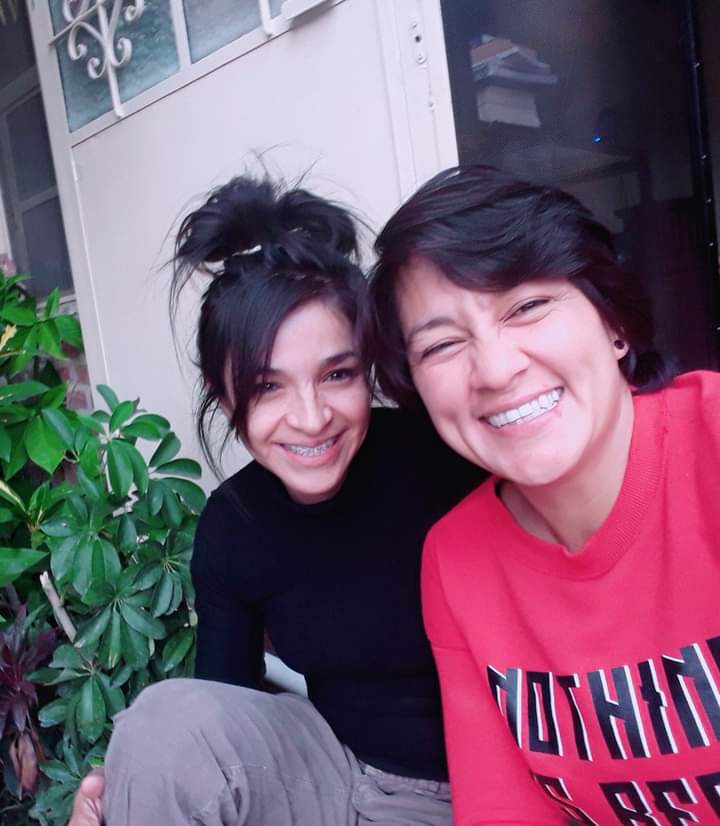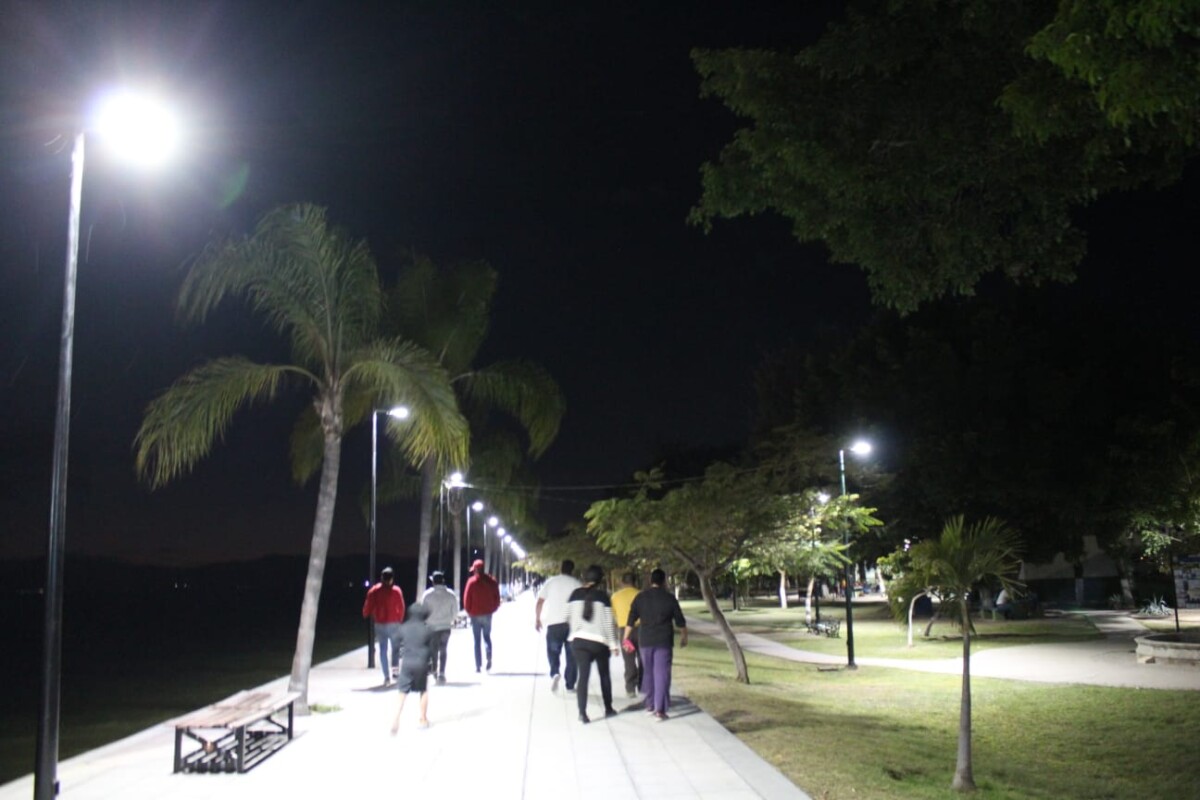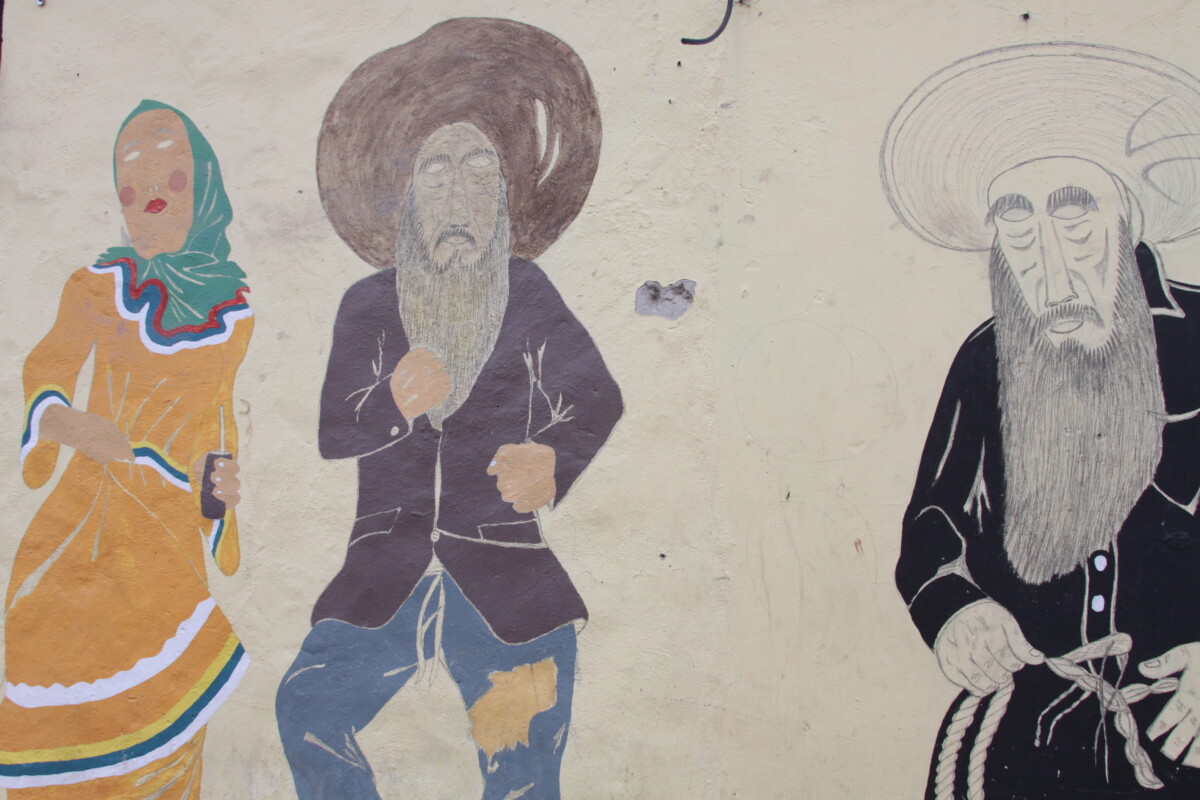gente
The Communal House of Ajijic will be more than an event hall
Casa Comunal of Ajijic is located at Galeana #289
Sofia Medeles(Ajijic).– The president of the Indigenous Community of Axixic, or CIA, Margarito Rojas Mora, clarified that the remodeling of the Casa Comunal is being done primarily in order to protect the collections and to provide a more comfortable space for the community member meetings.
In addition, the property, located at Hermenegildo Galeana #289, will be able to be used as an event hall by the members of the CIA.
The hall can also be rented out for parties upon request, with the intention of generating resources for the organization. Finally, Margarito Rojas reiterated that the money received was distributed to the community members and the rest was used for the remodeling.
Translated by Colleen Beery
The opening of formerly privatized streets in Chapala will continue
Alejando de Jesús Aguirre Curiel during an interview in his presidential office.
Jazmín Stengel (Chapala).– The campaign to recover public spaces will continue, declared Alejandro de Jesús Aguirre Curiel, president of Chapala, during an interview with the media on February 15.
When questioned by this reporter about whether the opening of privatized streets will happen in other subdivisions of the municipality, the mayor said that work is already being done in this regard. «As you have seen, we have already been working on it and we will continue,» he announced.
The first reopening of closed streets occurred in the Mirasol subdivision. This change provoked discontent from the subdivision’s residents. Aguirre Curiel reiterated that these streets will remain open, «The streets have to be open because the population of the area has grown.»
«The growth of the population is with its streets,» said the president, adding that the campaign to recover public spaces will not stop, as promised during my political campaign.
The authorities did not provide specific data on which streets will be reopened, nor how many subdivisions are in the same situation as Mirasol before this report went to press.
Translated by Nita Rudy
Weekend traffic in Ajijic jams highway and streets
Traffic on the Chapala-Jocotepec highway, near Rancho del Oro, in Ajijic. Photo: Sofía Medeles
Sofía Medeles (Ajijic).– In the last few weeks, traffic saturation on the Chapala-Jocotepec highway, at the height of Ajijic, as well as its streets, especially Ocampo, has been increasingly noticeable. This situation is changing from a holiday problem into a daily one, making it difficult for those who live in the town to use their cars.
On Sunday the 13th and Monday the 14th, there were lines of cars from San Juan Cosalá, due to the accident on the Guadalajara-Morelia highway at the intersection of El Molino, in Jocotepec. This accident caused cars to take up to 50 minutes to drive the three kilometers through Ajijic, also congesting Ocampo Street while it was used as an alternate route.
Although the traffic is not always this heavy, several drivers in the town said that it is increasingly difficult to drive in Ajjic, especially during rush hour.
«Normally, from two o’clock in the afternoon until four o’clock, the road fills up with cars from La Floresta and traffic starts to become lighter in Villa Nova (in Chapala). The problem occurs in La Floresta, where everyone starts to use the side roads, and they jam traffic. Then on Ocampo and Guadalupe Victoria, there is also a traffic jam, not to mention on Colón. I don’t know where so many cars come from and I don’t see a solution to the problem,» said Luis, a resident of Ajijic.
Another native of the town, Antonio, commented that some years ago these were problems that were only seen on vacations or when there were festivities, but since Ajijic was declared a Magic Town, it began to become a daily occurrence.
«On a Tuesday or Thursday, it has taken me up to 40 minutes to get through Ajijic. During rush hour they should assign traffic cops because there is no lack of visitors who want to go the wrong way on a street, just to get around the traffic on the highway. It happens a lot on Zaragoza Street, around Six Corners, and they don’t go slowly, they go very fast.»
Fany, a pedestrian in the area, confirmed that cars coming down to avoid traffic usually go at high speed. She said, «The children here on the block go out to play, plus there are several dogs. Cars going very fast don’t stop to see who might be trying to cross, they just think they are going down the road. They say that the traffic jam is due to the traffic lights not being synchronized, and if that is the case, the authorities should intervene quickly. Because it is not only the traffic, it can cause harm to the people who walk on the street.”
The director of Social Communication of Chapala, Elizabeth Oropeza Silva, commented that since the highway is a state highway, they haven’t asked for support from the State Government, for more police crs and traffic police. She also ruled out that the problem is due to the traffic lights, since they were maintained and synchronized at the end of the year.
Translated by Christalle Dalsted
Our Lady of Lourdes is celebrated in her namesake neighborhood
Our Lady of Lourdes during her coronation Feb. 11 in her neighborhood chapel.
Jazmín Stengel.- This year, the image of the Virgin of Lourdes got to know her neighborhood in depth. Due to the cancellation of the religious festivities and processions because of the pandemic, neighbors received the visit of the venerated image in their homes Feb. 11.
Since the usual procession to the church of St. Francis of Assisi was prohibited, the guard chose to go through the houses and streets of their neighborhood. This gave people an opportunity to enjoy the presence of Our Lady of Lourdes in an intimate setting.
“We were not going to stand idly by,” said Carmelita, who every year helps organize the carnival in the parking lot outside the Chapel of Our Lady of Lourdes, where the feast was usually held.
“We told the neighbors that they could not come in the procession, but that we would pass with the statue to their homes.” Said Carmela’s husband. They all ran to their homes to receive the sacred image. People liked this very much, since “it was something beautiful and unforgettable,” said a young neighbor.
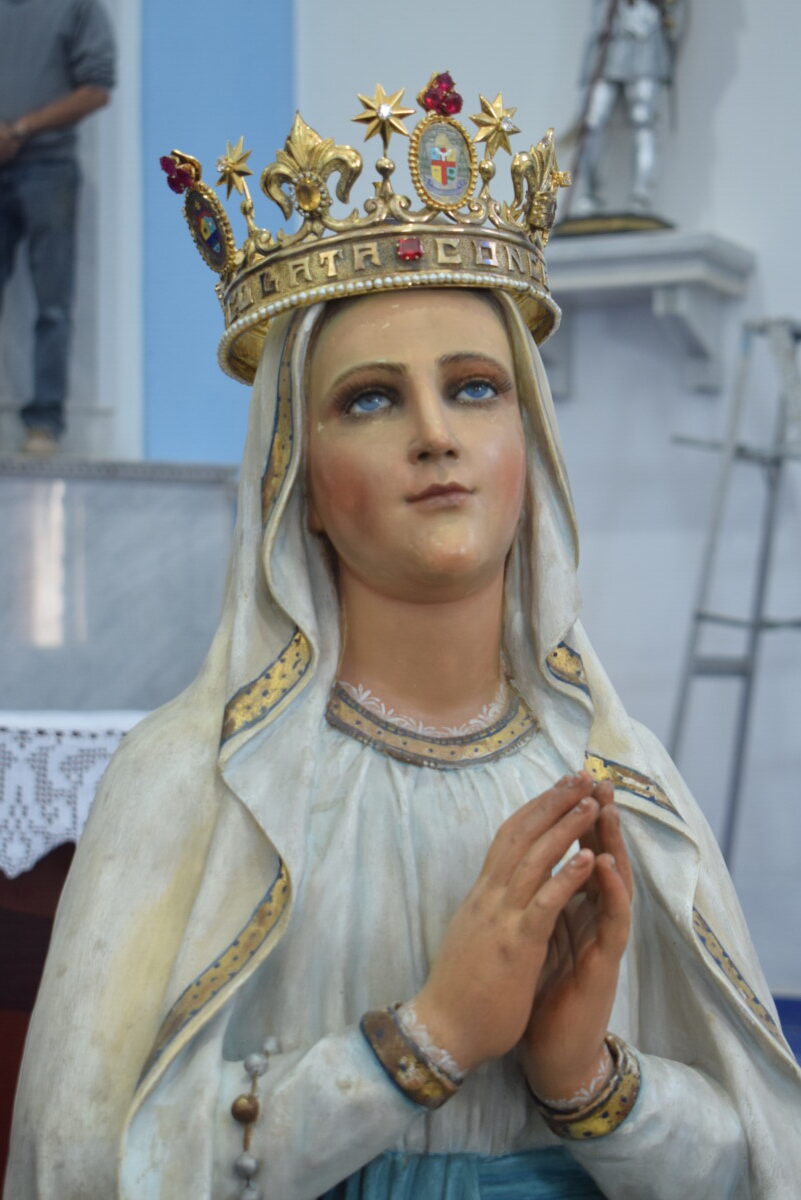
After she was crowned, parishioners thanked her for the miracles she has granted them.
The coronation of Our Lady of Lourdes usually takes place at 6 a.m. However, with the current restrictions and at the request of the priest in charge, it was postponed until the Mass of “the sick,” at noon. During that Eucharist, the people gave thanks for miracles the Virgin has granted them, kissing and caressing her once with her crown on.
The party used to last all night, with fireworks, rockets, drinks and lots of food. But that also was not possible this year. That did not change the faith, nor the loyalty of her parishioners who escorted her throughout the day until the removal of her crown, at almost at 10 p.m.
The crown was donated 50 years ago, according to the neighbors, by inhabitants of the French colony who helped build the Chapel of Lourdes in 1940, coordinated by Guillermo González Hermosillo y Brizuela.
Translated by Mike Rogers
Nina, the ‘miracle child’ embraced by Our Lady of Lourdes
Nina the first time she embraced Our Lady of Lourdes in front of her chapel. Photo: Daniel Padilla.
Jazmín Stengel (Chapala).- Twelve year-old Nina Yocelin Martínez Flores, daughter of Mara de Lourdes Flores López and Diego Ernesto Martínez Jiménez is considered the miracle of the year in the Lourdes neighborhood Chapala.
The teenager was diagnosed with leukemia in 2019. «It was a very serious situation, we did not know what to do about it,» said Diego, the girl’s father. Being a very religious family, the parents began Nina’s treatments, but trusted their faith.
In spite of the desperation and how complicated it is to help a family member lying in a hospital bed, the Martínez Flores family received a lot of help. “Every time I arrived with my mother, the neighbors or relatives had left something to support us,» said Diego.
After a year of treatment, Nina was able to return home. Her father Diego, an active participant in the vigil of St. Francis of Assisi, asked permission to receive the statue of Our Lady of Lourdes and lay his daughter at the feet of the Virgin. Incredibly for all present «the Virgin embraced Nina,» commented neighbors after seeing Daniel Padilla’s photograph.
Nina says that on that day the Virgin, in her invocation of Our Lady of Lourdes, spoke to her as she went up and embraced her. She heard a clear voice that said «you are going to be cured, daughter, you are going to be cured». Although the parents were skeptical at first, the confidence that their daughter showed, made them believe.
It was not the only time something similar happened, in the last three years Nina’s parents have taken her to view the Virgin of Lourdes and St. Francis of Assisi. On more than one occasion the now teenager had unexplainable experiences, in which she claims to have heard voices or felt observed by the images in the temples.
After three years of continuous treatment, Nina Yocelin Martinez is stable. This miracle strengthens the faith of the neighbors of the Lourdes neighborhood. Although leukemia is a disease with regular relapses, the girl has not had any so far.
Translated by Christalle Dalsted
Mimi and Judo: a genuinely unconditional love
Mimi Martínez and Judo Zamora, both from Ajijic, have been in a relationship for just over four years.
Sofía Medeles (Ajijic).- This is the story of Noemi Milagros Martinez Romero – «Mimi» and Judith Reyes Zamora – «Judo,» two women who, despite the ups and downs of their relationship, have fought against rejection, discrimination and criticism to move forward together.
Although they were neighbors in their youth, they actually met just under five years ago when Judo moved into an apartment near Mimi’s current residence. In a short time, they went from sharing greetings to having coffee; after four months of living together, their friendship turned into love.
«I liked Judo and flirted with her, but since I have my family, she didn’t think I liked her. Love stirred during those four months of living together, visits and so on,» said Mimi.
The beginning of their romance was difficult mainly because of their families, but also due to the discriminatory comments of the people around them. «Family opinions played an important role. When my family found out, many turned away and didn’t accept it. It took time for them to agree with what I wanted,» Mimi said.
Judo added that her close ones also put a «but» in front of the relationship due to the fact that Mimi already had children, but the couple overcame the criticism. «Eventually, we decided that other people were not going to make us happy. The relationship is about us, no matter what other people think.»
Mimi stated that her priority was her children, who accepted their relationship in the best way, showing that the only thing that mattered to them was their mom’s happiness.
«It’s an easy relationship, but it’s hard in this case because I have a family. Judo not only deals with my personality, but also with the personalities and dynamic of the five of us. Judo has been very supportive, because she has always had a good friendship with my children. She has represented the figure that is missing in the family, and she is both their confidante and their support.»
In the middle of the pandemic they got engaged, but they wanted to be sure before getting married that they had taken steps to build a strong foundation for their future life.
«For us, marriage is a symbol that our relationship is afloat despite everything we have been through, as well as being a document that formalizes the relationship. It is important because it represents the union we have,» added Mimi.
They also reaffirmed their support for each other’s work. Judo, who owns Lucky Bar, said that Mimi had helped her decorate and often assists her in events. For her part, Mimi has her craft and gift business called Nahomi’s Mimi Craftmiss, for which Judo has always shown her unconditional support.
Finally, they had advice for those who wish to be happy: «If you start thinking about all the criticism, you will never move forward. But when you know what you want, you have no choice but to fight against the world for a time and then you will be at peace with your choice.»
Although the beginning of their romance was difficult because of «what people will say,» now they live their love in freedom and are already engaged.
«We are already in the 21st century. After the pandemic, we learned that there is no time to lose; we have to look for and fight for what makes us happy, no matter what people say. We must seek happiness and emotional balance, anything else is extra,» concluded Judo.
Marriage equality has been legal in Jalisco since 2016. More recently, the state no longer requires couples to file a protective lawsuit, and they can get married in any civil registry of the state.
Translated by Rebecca Zittle
Light bulbs replaced on on Ajijic malecon
70 new lamps light up Ajijic’s malecon. Photo: Sofía Medeles.
Sofía Medeles: Personnel from the Ajijic delegation replaced the bulbs of 70 streetlamps To improve illumination on the malecon.
The installation work, as well as the pruning of some trees, was carried out on Wednesday, February 16. The new bulbs are distributed between the walkway and La Amistad Park.

Delegation personnel carried out the installation last February 16 on the malecon. Photo: Sofía Medeles.
Maximiliano Macías Arceo, the acting delegate of Ajijic, stated that bulbs that were removed but still work will be placed in areas with lighting problems, such as Lázaro Cárdenas Street or La Canacinta neighborhood.
Translated by Sandy Britton
Lakeside Chronicles: The sayaco is the inner child
Front wall of the Romero Pérez brothers’ home is illustrated by masked Sayacos, created by Aarón, one of the brothers. Photo by: María del Refugio Reynozo Medina
María del Refugio Reynozo Medina (Ajijic).- José de Jesús Romero Pérez still has the first hermit-like sayaco mask he made 15 years ago. The dark brown, immobile, sharp face is made of copal, a wood that he brought from the hills. The hollows of the eyes and the slightly open mouth are decayed. The eyebrows, beard and straw-colored mustache are made of a fiber obtained from coffee sacks.
Making a mask can take José de Jesús about two and a half weeks, working in the afternoons after his usual workday. Although he does not make them for commercial purposes, the unique masks which bear his signature, can sell for up to three thousand pesos. The masks that depict women (sayacas) are colorful, with embossed or painted eyelashes and eyelids splashed with glitter. Once carved with a chisel, vinyl paint is used to outline the eyebrows, eyes and eyelashes. The lips and cheekbones are painted deep red circles.

Abel and José de Jesús Romero Pérez grew up watching the sayacos and chasing them in many celebrations. Photo by: María del Refugio Reynozo Medina
The male masks of the sayacos are made of natural light or brown wood, with long beards, bushy eyebrows and moustaches made of horsehair. Romero Pérez’s masks are instantly recognizable. The images flow, as he chisels each feature. A face will emerge unexpectedly from the wood. He knows perfectly well the type of wood needed to design each face. In addition to wood from the native copal tree, he uses native tecomaca wood, which is soft and light.
He has sold eight masks. Buyers do not necessarily wear them in parades. They are purchased by collectors as unique pieces, inspired by the sayacos.
The Romero Pérez brothers Abel, José de Jesús, Gaspar, José, Aarón and Modesto, each year transform themselves into sayacos mainly to inaugurate the carnival. They also attend other celebrations throughout the year.
On a wall outside their home there is an unfinished mural painting drawn by Aarón. The image shows a dancing female sayaca dancing wearing a yellow dress trimmed with colored ribbon and brown booties, accompanied by two male sayacos. One is dancing wearing a brown jacket, denim pants and booties. The other sayaco has a black dress with white dowels as buttons. All of them have long faces, although their appearance in the parades brings smiles and laughter.
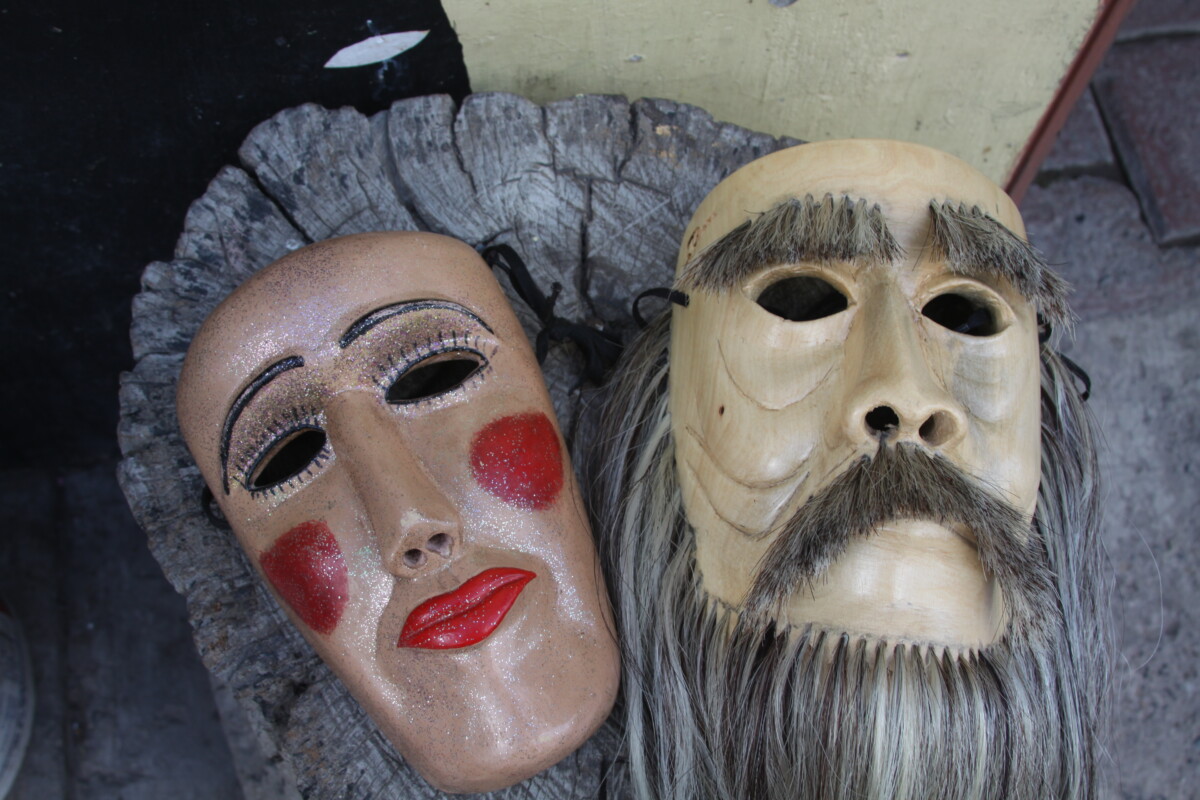
With copal or tecomaca wood, the masks made by Jesús Romero are unique pieces. Photo by: María del Refugio Reynozo Medina
“The sayaco is a very old character in the life of the people of Ajijic”, says Abel. They used to be called sayacal. Now they are called sayacas and sayacos. It is that mocking character that appears mainly in the carnival. They throw confetti and sometimes flour. Sometimes the flour is delicately smeared on their cheeks.
One of the main dances of the sayacos is called the dance of the «papaqui» which is accompanied by wind instruments. Sometimes they are invited to perform their dances at weddings or quinceañeras, the celebration of a girl’s 15th birthday. Abel remembers as a child watching the sayacos in the daily festivities. He and his siblings would race through the cobblestone streets following and teasing the sayacos amidst happy laughter.
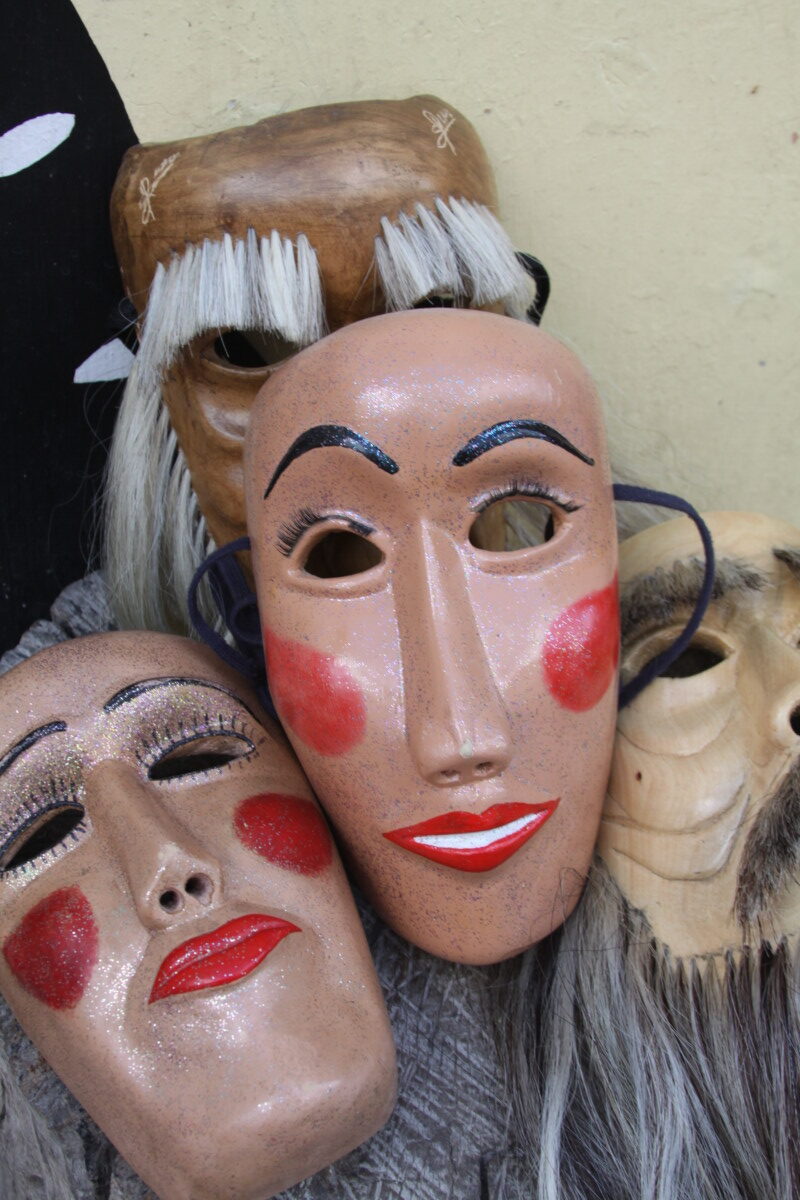
The masks of Jesus Romero Perez stamped with his signature can be worth up to three thousand pesos. Photo by: María del Refugio Reynozo Medina
The carnival parade is open to the entire population and a diversity of characters appear. The traditional attire is wooden or papier-mâché masks, sacks, shirts with dowels, booties, and hats. The sayacas wear bright printed dresses.
There is pride in being a sayaco. It is a nice, mocking, very old character who makes people laugh. The sayacos are mainly men. Even the sayacas are usually men because of the pushing, shoving, brawling atmosphere.
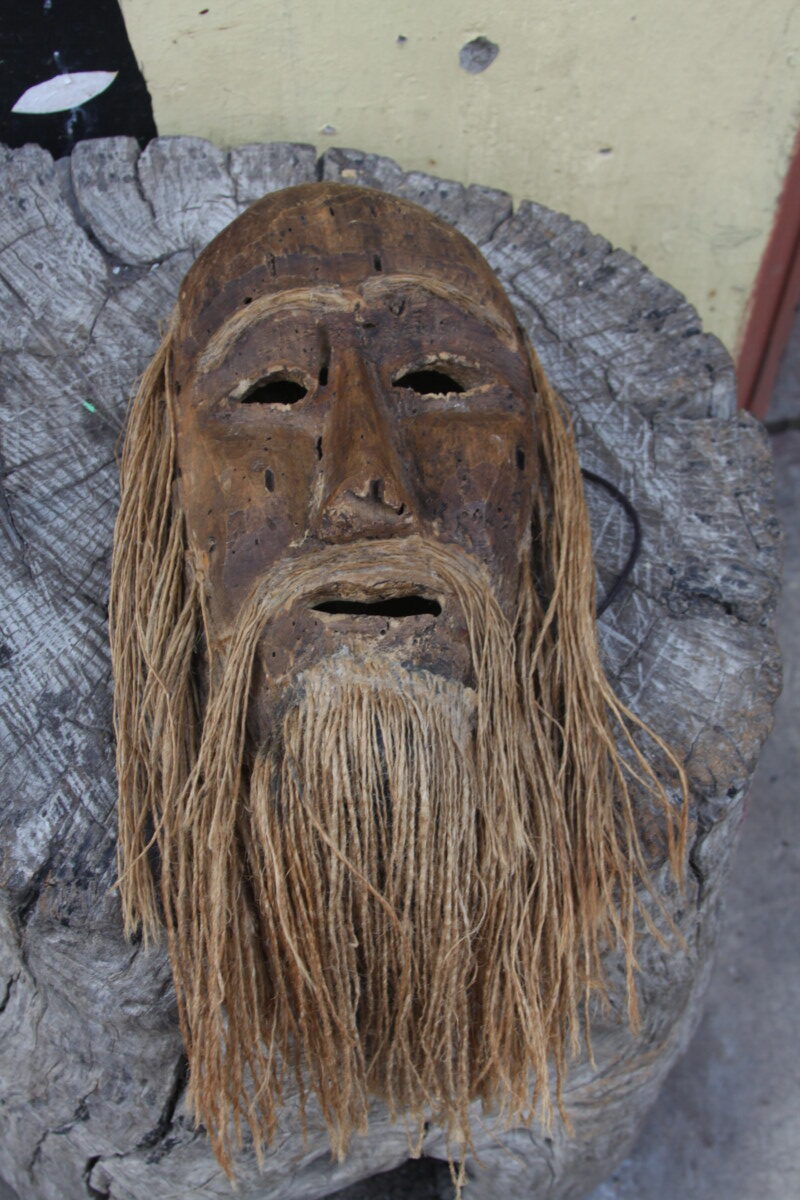
The first mask made by José de Jesús Romero Pérez was of a hermit in copal wood. photo by: María del Refugio Reynozo Medina
Behind the masks of tough men or picturesque red-cheeked women are the Romero Perez brothers. They appear in the parades and processions so that the legendary figures of the sayacos do not die and because Abel says «behind the wooden masks is the inner child.»
Translated by Nita Rudy
Health & Wellness:
By Leticia Trejo
The beliefs that dwell deep in our minds are the hardest to eradicate. For many years I firmly believed that 30 minutes of physical activity a day was what everyone needed to be fit and improve their health. That is, until I read an interesting piece of research that convincingly proved the 30 minutes a day claim was a myth.
Researchers chose 300 people from a company with a working schedule from 9 a.m. to 5 p.m., and 150 of them (office administrative workers) were asked to do 30 minutes of exercise a day. They could choose between going to the gym, getting on a treadmill or going for a walk outdoors. The other 150 – workers from the cleaning and maintenance service of offices throughout the building – were asked to continue their daily activities. Evaluation was through a blood test at the beginning of the study that measured levels of triglycerides, cholesterol and sugar. This evaluation was repeated after six months. The surprise for everyone was that the cleaning and maintenance workers had better test results than those who integrated 30 minutes of exercise into their daily routine.
This is not to say that exercise doesn’t work, but that sedentary lifestyles can kill us. Some scientists even say that sitting at a desk for eight hours is equivalent to smoking a pack of cigarettes a day.
Ian Jansen, Ph.D., is a professor in the Department of Public Health Sciences of the School of Kinesiology and Health Studies at the Physical Activity and Obesity Research Institute in Canada. In addition to this study, he has conducted many more on the influence of sedentary behavior on health.
This reminds me of the time I heard – during an international congress – the perfect formula for maintaining physical health. A very important lecturer gave a talk full of knowledge and wisdom about stress, exercise and life habits. In the question and answer segment someone asked him, «Professor, what is the ideal formula to be in shape?» He answered, «Go for a walk with your dog three times a day, after every meal… whether you have a dog or not.» The auditorium was full of laughter, but he was right. Our lives should be physically more active. For example: use the car less; walk more to stores, banks and malls; do the house cleaning yourself; and walk 20 minutes after every meal.
A doctor who was my friend and student in yoga classes told me another way. He said when a patient asked him how often they had to exercise he would answer, just every time you eat.
This applies perfectly to people who are not physically active, because Dr. Jansen studies sedentary lifestyles. But for people who have been athletes, gym lovers, fitness friends or intense marathon runners, he applies a different rule: Relax the same amount of time they trained. An alternative is that after an intense workout, they should not repeat the activity until after 24 hours so that there is a good recovery. We will write about these intense people in the next edition. In the meantime, I hope you had a happy Day of Love and Friendship on February 14, and received and delivered great amounts of kindness and gentleness.
Translated by Mike Rogers
Farm worker dies after falling out of pickup truck
The accident was recorded on the Guadalajara-Morelia highway, at the height of San Luis Soyatlán.
Laguna Staff.- A berry picker died after falling from the truck in which he was being transported. Despite the rescue efforts of his colleagues, the Chiapas native died.
The accident occurred on February 10 at around 5:30 in the afternoon in San Luis Soyatlán, municipality of Tuxcueca, when, as the vehicle entered the Guadalajara-Morelia highway, the worker fell to the asphalt.
The male, who was a migrant from Chiapas and was riding alone in the back of the vehicle, died after the impact. Although the emergency occurred in the neighboring municipality, the ranch for which the deceased worked belongs to producers from Jocotepec.
Translated by Sydney Metrick
© 2016. Todos los derechos reservados. Semanario de la Ribera de Chapala

